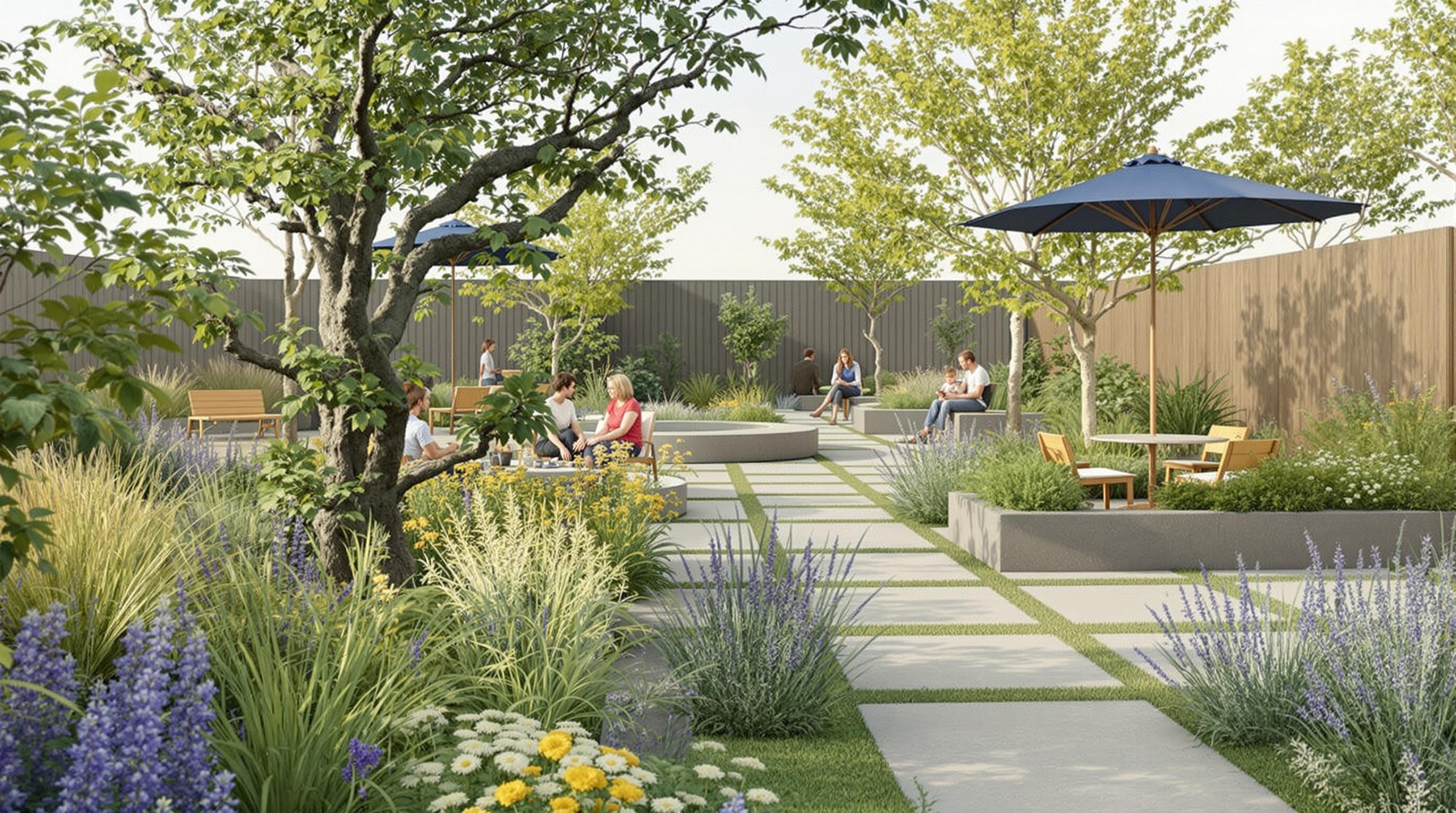Featured Articles
- 12 Innovative Strategies to Design Outdoor Spaces that Enhance Mental Wellness and Cognitive Function
- Blending Nature and Nostalgia: Designing Outdoor Spaces Inspired by Forgotten Childhood Playgrounds
- Rewilding Urban Landscapes: Transforming Concrete Jungles into Biodiverse Outdoor Sanctuaries
- Rewilding Urban Spaces: Designing Outdoor Retreats Through Nature's Chaotic Beauty
- Unconventional Outdoor Oasis: Transforming Urban Rooftops into Lush Green Retreats for Mindful Living
Rewilding Urban Landscapes: Transforming Concrete Jungles into Biodiverse Outdoor Sanctuaries
Rewilding Urban Landscapes: Transforming Concrete Jungles into Biodiverse Outdoor Sanctuaries
The transformation of urban landscapes into vibrant ecosystems, known as rewilding, offers a pathway to enhance biodiversity and improve the quality of life for city residents. This article explores the myriad benefits of rewilding, thriving examples from around the globe, and practical steps we can take to cultivate outdoor sanctuaries within our concrete jungles.
Understanding Rewilding
Rewilding is more than just the return of nature; it’s a movement that beckons us to reconsider our relationship with the environment. It involves the restoration of ecosystems to a natural state, encouraging natural processes to take charge and allowing wildlife to thrive. This concept is particularly crucial in our urban landscapes, where concrete often reigns supreme and nature is relegated to parks and green patches.
Why Rewild Urban Spaces?
As of 2021, over 55% of the world's population lived in urban areas, a figure that’s projected to rise to 68% by 2050 (United Nations, 2019). In such densely populated regions, the challenges of air quality, heat islands, and decreasing biodiversity are mounting. Rewilding could provide crucial solutions to these pressing issues.
Studies show that urban green spaces can reduce heat by up to 5 degrees Celsius (Palaniappan et al., 2018). With cities often becoming uncomfortable due to extreme temperatures, this cooling effect impacts housing costs, health expenses, and overall quality of life. Moreover, a study published in “Environmental Science & Technology” indicates that access to green spaces can improve mental health outcomes, reducing urban stress and anxiety levels (DeBell et al., 2017).
The Economical Aspect of Rewilding
When we think about rewilding, we often overlook the economic benefits it can yield. For instance, neighborhoods with vibrant green spaces typically see a boost in property values—studies indicate a 15-20% increase in property prices near parks and gardens (The National Association of Realtors). Additionally, urban rewilding can lead to reduced stormwater runoff, thus lowering municipal costs for drainage systems. Moreover, a biodiverse urban habitat can attract tourism and create job opportunities related to environmental sustainability.
Examples of Successful Urban Rewilding
One of the shining examples of urban rewilding is the High Line in New York City. This elevated linear park was once an abandoned railway line, transformed through community efforts into a thriving green corridor. The High Line features native plants, provides habitat for birds and insects, and serves as a popular gathering space—a testament to how creative thinking can turn a forgotten structure into an ecological haven.
Across the Atlantic, the city of Berlin has demonstrated an impressive commitment to rewilding by preserving and revitalizing over 40% of its land as green space. Urban gardens, green roofs, and public parks not just beautify the city but also support its biodiversity. The ‘Berlin Green Network’ is an initiative that aims to interconnect these green spaces, allowing wildlife corridors to flourish amidst urban environments.
Personal Stories That Inspire Action
Imagine a young girl named Mia, who lives in a cramped apartment in downtown Chicago. Every day after school, she slogs through the concrete pathways, dreaming of green fields and chirping birds. One summer, a local initiative transformed a vacant lot into a beautiful community garden. That garden became Mia's sanctuary; it buzzed with bees, burst with colors, and flourished with organic veggies. She learned to plant and care for her little patch, connecting with nature and her neighbors alike. Suddenly, the drab backdrop of her city felt alive with purpose—as well as a sense of community. Mia’s story highlights how rewilding can foster connections not just between people and nature but also within communities themselves.
Barriers to Rewilding
While the benefits seem boundless, the path to rewilding urban landscapes is fraught with challenges. Some urban planners resist green initiatives due to the fear of increased maintenance costs. Furthermore, a lack of knowledge about the ecological advantages of native species can hinder progress; many cityscapes favor non-native plants that offer less biodiversity. Educating communities and local authorities about the long-term benefits and cost savings could significantly shift their perceptions.
Additionally, bureaucratic red tape can slow the implementation of rewilding initiatives. Lengthy permitting processes and zoning regulations might seem daunting, but creative thinking can pave the way forward, leading to more flexible policies that encourage biodiversity.
Perspectives on Community Engagement
An essential component of successful rewilding efforts is community engagement. Bottom-up initiatives where residents partake in the planning and implementation can yield profound results. Take the example of Porto, Portugal, where the local community took it upon themselves to transform abandoned lots into green micro-parks, bridging both social and ecological gaps.
Programs like “Adopt-a-Park” or volunteer planting days empower citizens by allowing them to take ownership of their environment, thus fostering a sense of responsibility and connection. Moreover, educational workshops can provide the knowledge needed to sustain these efforts long-term, reinforcing the notion that everyone can contribute to the greening of their city.
Future Directions and Innovations
The future of urban rewilding looks promising with rapid innovations in technology and design. Vertical gardens, rooftop habitats, and the integration of smart technology such as sensor-based irrigation systems allow cities to be creative in their greening efforts. For instance, Singapore’s Gardens by the Bay uses cutting-edge technology to maintain a lush environment while ensuring sustainability—blending modernity with nature seamlessly.
Furthermore, the practice of permaculture is gaining traction in urban settings. By mimicking the natural ecosystem processes, practitioners not only create self-sustaining gardens but also contribute to food security within cities. This growing trend is not just an aesthetic choice; it’s a movement towards resilience in increasingly unpredictable climate conditions.
A Call to Action
As a 25-year-old urbanite, I recognize that my generation bears the responsibility for the future of our cities. If we foster a culture of rewilding, we can transform our urban landscapes into thriving, biodiverse sanctuaries. There's a saying that the best time to plant a tree was twenty years ago; the second-best time is now. We can start by advocating for policies that support green initiatives, volunteering for local rewilding projects, or even starting small by creating native gardens in our neighborhoods.
With each tiny effort, from planting a single flower to participating in community initiatives, we’re not just altering our local environment; we’re making strides toward addressing the globally significant issues of climate change, biodiversity loss, and urbanization. We owe it to ourselves and future generations to plant the seeds of change. Let’s reclaim our concrete jungles and transform them into flourishing oases of life.
Conclusion: The Road Ahead
As we survey the future of urban living, rewilding stands as a beacon of hope—a reminder that nature can flourish amidst the concrete and steel. The integration of wildlife into our daily lives enhances our environment, strengthens our communities, and supports mental and physical well-being. With determination, creativity, and collaboration, we can weave threads of biodiversity back into our urban tapestry. So, let’s grab our garden tools, assemble our neighbors, and embark on a mission to reclaim our cities one plant at a time!




